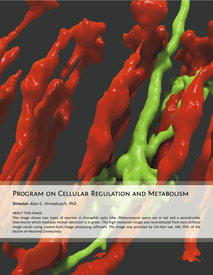You are here: Home > Program in Cellular Regulation and Metabolism
Program in Cellular Regulation and Metabolism
Director: Alan G. Hinnebusch, PhD
The seven investigators in this program, all belonging to the Laboratory of Gene Regulation and Development (LGRD), apply a combination of genetics, biochemistry, cell biology, and structural biology to elucidate the molecular basis of processes fundamentally important in cell biology or animal development. Three of the seven groups study molecular mechanisms of transcriptional and translational control of gene expression and the transposition of retroelements in budding or fission yeast. Two groups employ the fruit fly Drosophila to investigate visual circuit functions and molecular mechanisms in neurodevelopment, including synaptic specificity in the visual system and glutamate receptor clustering at the neuromuscular junction. The anuran Xenopus laevis serves as a model system for the work of the remaining two groups, one of which focuses on spindle assembly and chromosome segregation and the roles of covalent protein modification by SUMO in regulating these events, and the other on transcriptional programming in adult stem cell development during metamorphosis.
Members of the Section on Nutrient Control of Gene Expression, headed by Alan Hinnebusch, study mechanisms of transcriptional and translational gene regulation in budding yeast. Recently, they provided evidence that the cyclin-dependent kinases Cdk7/Kin28 and Cdk9/Bur1 promote a dual mechanism for recruiting the transcription elongation factor Paf1C via the phosphorylated forms of hexad C-terminal repeats of Spt5 and heptad repeats of the RNA Pol II C-terminal domain. They also found that discrimination against AUG start codons with unfavorable sequence context involves, in translation initiation factors eIF1, eIF2b, and eIF1A, the same domains and residues that discriminate against non-AUG start codons, suggesting that context nucleotides and AUG act together to promote the closed conformation of the preinitiation complex required for start codon recognition.
The Section on Cell Cycle Regulation, headed by Mary Dasso, studies mechanisms that assure accurate chromosome segregation in metazoan cells. The group recently showed that the SUMO pathway for covalent protein modification plays an essential role in the assembly of kinetochores, the proteinaceous structures that attach sister chromatids to mitotic spindles. The group also studies the roles of nuclear pore complex proteins and Ran GTPase pathway components in the robust formation of the microtubule fibers that link kinetochores to mitotic spindles and mediate the segregation of chromosomes into daughter cells at anaphase.
The Section on Protein Biosynthesis, headed by Thomas Dever, is characterizing the structure and function of several translation initiation factors and the molecular principles of kinase-substrate recognition by the stress-responsive eIF2a kinases. The group recently characterized a human X-linked intellectual disability syndrome caused by a mutation in eIF2g that impairs eIF2b binding, thus providing a molecular basis for the human disease. They also identified eIF2 contacts with the ribosome and revealed an unexpected structure of the eIF2–Met-tRNAiMet complex, reported that the Plasmodium PK4 kinase phosphorylates eIF2a, and demonstrated that the hypusine-containing protein eIF5A promotes translation elongation.
Henry Levin heads the Section on Eukaryotic Transposable Elements, which analyzes LTR retrotransposons and the integration of their cDNA into the chromosomes of host cells. Recently, the laboratory adapted methods of deep sequencing to determine the positions of retrotransposon Tf1 integration throughout the genome of Schizosaccharomyces pombe. The group's new methods are capable of measuring levels of integration at individual nucleotides and have provided a reproducible and saturating profile of integration activity for each intergenic sequence and gene-coding sequence. In other studies, the laboratory adapted the Hermes transposon from the housefly to generate maps, of unprecedented density, of integration in S. pombe. The profiles identify a comprehensive set of essential genes, but it is notable that nonessential genes important for robust cell growth are also identified by their intermediate levels of insertion.
The Section on Neuronal Connectivity, headed by Chi-Hon Lee, investigates the development and function of color-vision circuits in Drosophila. His group uses high-resolution imaging and genetic approaches to determine the molecular mechanisms of dendrite development. The group revealed that TGF-beta/Activin signaling regulates dendritic branching of optic lobe neurons and consequentially controls their synaptic specificity. For studying visual functions, the group combines behavioral and molecular approaches to identify the neural circuits and mechanisms that process color information.
The Unit on Cellular Communication, headed by Mihaela Serpe, investigates molecular mechanisms that regulate cellular signaling during development, employing the Drosophila system. The group recently identified a neuropillin and tolloid-like protein, Neto, as a component essential for clustering the ionotropic glutamate receptors at the Drosophila neuromuscular junction. The group's studies demonstrated that Neto functions as a non-channel, essential subunit of glutamate receptor complexes and is required for organization of postsynaptic densities and synapse functionality.
The Section on Molecular Morphogenesis, headed by Yun-Bo Shi, studies the gene-regulatory mechanisms controlled by the thyroid hormone receptor (TR) that establish the postembryonic developmental program in vertebrates. Using metamorphosis in Xenopus laevis and Xenopus tropicalis as a model, the Section discovered that, to regulate target gene transcription, liganded TR causes nucleosome removal and distinct changes in several histone activation and repression marks. The group also revealed that adult intestinal stem cell formation during metamorphosis requires TR–induced cell-cell interactions, in part through sonic hedgehog signaling.


